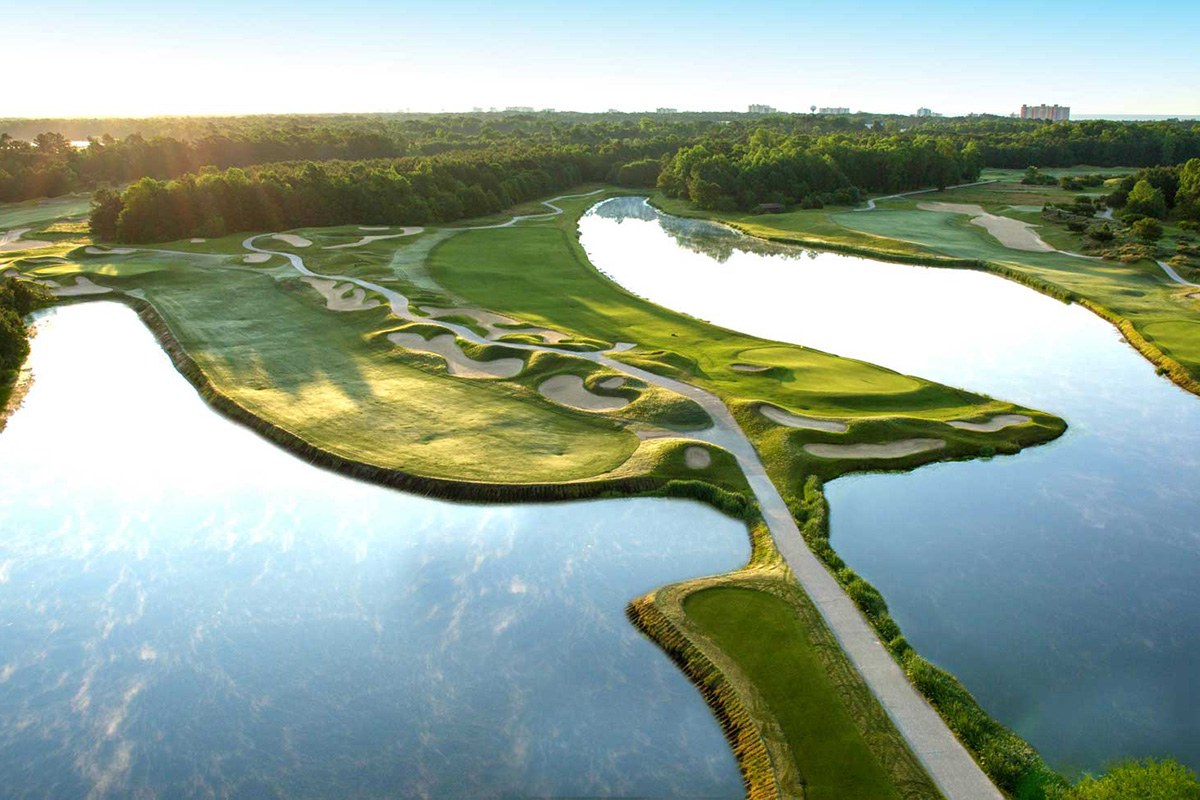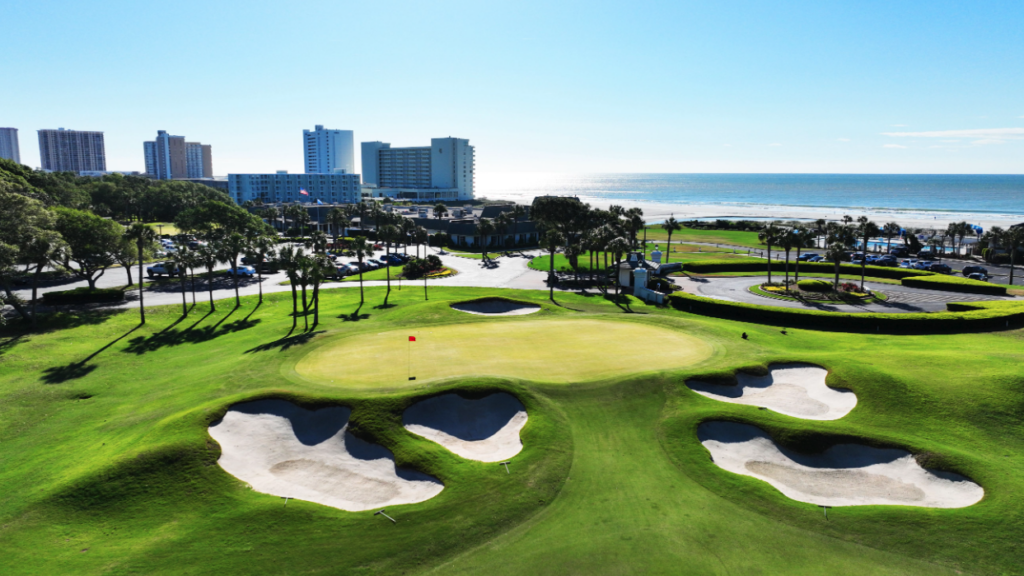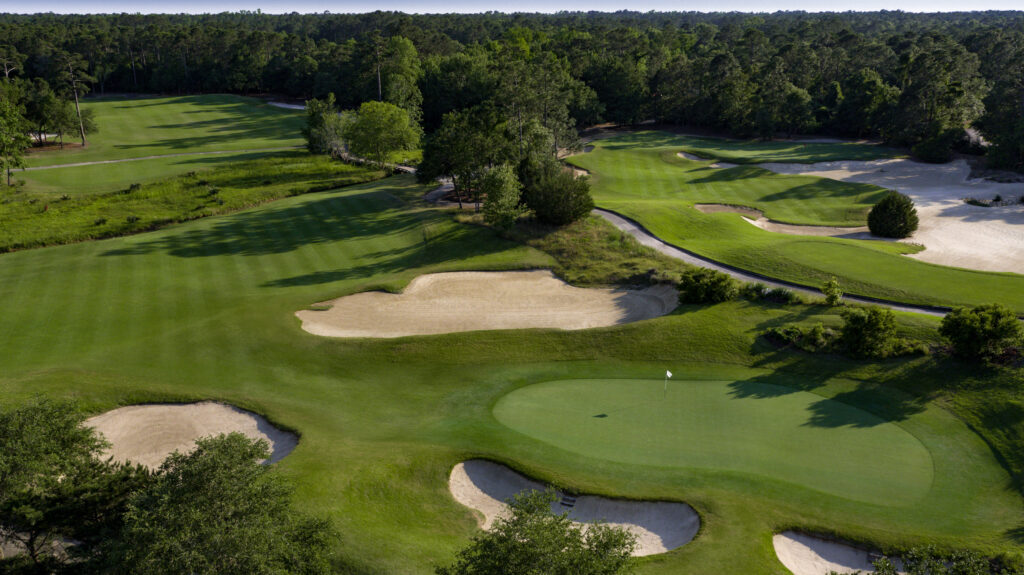
The Dye Course at Barefoot Resort
South Carolina’s Myrtle Beach and its surrounding areas remain one of the top destinations in the country for golf buddy trips and quick getaways.
And it’s easy to understand the draw – there are more than 90 courses in the area, which runs south from the North Carolina border through Myrtle Beach proper to Pawley’s Island and Georgetown, with facilities at various levels of challenges and myriad price points and a variety that keeps both high-handicappers and scratch golfers happy.
The beaches and courses and other attractions of the “Grand Strand” are within a half-day’s drive from many golfers from the East Coast, the Mid-South and even the Midwest. Nestled along the pristine shores of the Atlantic coast, Myrtle Beach bills itself as the “Golf Capital of the World.”
Many of the courses here are designed by the world’s top golf architects. It’s hard to go wrong with most of the offerings in the Myrtle Beach area, but the seven we have listed below are among our favorites and give golfers a solid taste of what the destination has to offer.
The Dunes Golf & Beach Club still sets the standard
Since its opening in 1948 as just the second course in Myrtle Beach, the Dunes Golf & Beach Club has remained on the list of must-plays when in the area. Designed by Robert Trent Jones (the elder) the Dunes is set a block from the beach but is not a links-style course, with the ninth hole being the only one where you see the ocean. But that doesn’t mean the course is not affected by the breezes, and that aspect adds to a routing that has parkland and marshland elements.
The Dunes Golf & Beach Club’s holes are lined with beautiful old oaks and water comes into play by way of ponds and marshes on more than half the holes. Most holes end with segmented and elevated green complexes, which have stood the test of time.
Part of the appeal are other Trent Jones trademarks like long, runway tee boxes, plenty of well-placed bunkering in the fairways and risk-reward options on most holes that can mean easy par if you choose the safer option and difficult birdie – with a risk of much worse – if you choose the riskier play.
The Dunes Golf & Ocean Club has hosted the US Women’s Open (in 1962) and the PGA Tour Q-School and will be the site of this year’s Myrtle Beach Classic on the PGA Tour in May, the first major professional golf tournament on the Grand Strand in 24 years.
The Dunes Golf & Ocean Club was ranked No. 59 on the Golf magazine’s most recent Best Courses You Can Play list.

The Dunes Golf & Beach Club
Barefoot Resort features quartet of courses, all with different tests and personalities
The Barefoot Resort in North Myrtle Beach has a little bit of everything, but the main draw is a quartet of courses by designers each known for his own style, degree of difficulty and signature flourishes. The foursome of tracks here were fashioned by Pete Dye, Greg Norman, Tom Fazio, and Davis Love III, and each has been ranked as a top track by major golf publications.
What’s cool is that each course – just like the man who fashioned it – has its own personality.
The Dye course at the Barefoot Resort is the only semi-private course on the property and is set off from the other courses on the northern end of Barefoot and routed through the white sands of the Carolina Bays. Mounding, elevation changes and as many as 200 bunkers, only a fraction of them actually in play, are evident throughout the course, which is considered by many to be the most difficult course of the four at Barefoot Resort.
Fazio’s layout is the most visually stunning and plays through rolling, secluded terrain that might have you thinking about the classic, inland courses of the Carolina Sandhills. It’s well bunkered, but not in an intimidating way, with any of the hazards placed for appeal and only come into play with the most errant of shots. Natural elevation changes add a sense of drama and excitement to the round, with extensive tree cover throughout and water features visible on 15 holes – many of the lakes are in out-of-play areas to ensure playability.
The Norman-designed course is thought to be the real “resort” option on the property and more forgiving than the other three. Despite large waste areas and seven holes along the Intracoastal Waterway, it is the perfect high-end “starter” course, according to the resort’s website. Sod wall bunkers will be seen throughout and bump-and-run shots often provide an effective and necessary means of getting the ball onto the putting surfaces. There are undisturbed trees and wetlands at nearly every hole, and the entire experience is memorable.
And finally, the Love course is the best of all worlds at Barefoot. It allows golfers the freedom to grip it and rip it – the driver can be your best friend at this layout. It’s a traditional track that incorporates the re-created ruins of a 17th Century plantation in a similar fashion to courses found in Scotland and Ireland and has generous landing areas and demanding greens complexes. The putting surfaces are very much in the Donald Ross style, and, as with most of Ross’s courses, short is definitely better than long and the edges are cut tight to draw shots into collection areas.
An entire golf vacation could be spent at the 2,377-acre Barefoot Resort and nothing that the Myrtle Beach area has to offer would be missed.

The Love Course at Barefoot Resort
Sister courses in Pawley’s Island rated among the best in the U.S.
In the town of Pawley’s Island, some 20 miles south of Myrtle Beach, the late golf architect Mike Strantz designed sister courses within an earshot of each other – the sublime Caledonia Golf & Fish Club and demanding True Blue Golf Club.
Caledonia and True Blue both sport Strantz’s hallmarks: undulating greens, well-positioned and diabolical bunkers, and forced carries that reward or punish risk-takers. Repeat play helps revel in his subtle touch and keen eye for detail. The courses are individually distinctive but perfectly complement each other. Caledonia is tight, a bit claustrophobic at times and picture-perfect pretty at every turn; True Blue is long and difficult and unforgiving, with more Strantzian quirks.
Caledonia has few forced carries, and the mounding, while present, is generally subdued as the trees and sand determine the way golfers must play the course. There’s a gentle sculpting of the terrain, with an occasional accentuation to lend the setting flair.
Playing at a par of 70 and only 6,526 yards from its back (pintail) set of tees, Caledonia will not overwhelm you with length. But from the tips the layout can be very tough while offering risk-reward opportunities in spades. High handicappers love the landscaping and four sets of tees.
Caledonia Golf & Fish Club is a work of art, both in design and execution, laid upon a parcel with a rich history, Deep South accents, and visual cues of its former life as a working plantation. The place exudes personality from every pore and a round at Caledonia is truly a magnificent experience.

Caledonia
True Blue features uncommon elevations and naturally rugged terrain. The rough, sandy areas (all of which are played as waste bunkers by local rule) provide striking contrast to the verdant greens, tees and fairways.
More exuberant in design than Caledonia, True Blue is representative of Strantz’s knack for crafting strong landforms. Mounds grow to impressive heights, bunkers abound and carries over water are everywhere. At True Blue everything is big, with expansive fairways and huge greens, some of whose pin placements can result in a three-club difference.
True Blue has been described as “Caledonia on steroids.” Soon after it opened, it earned another moniker: “Golf Heaven and Hell,” because of its difficulty. Eventually, the course was revamped and slightly modulated by eliminating some of the blind shots.
True Blue is a very scenic track, with its back nine weaving through woodlands and it is ultimately very playable and interesting. There is hardly a weak hole anywhere. Golfers have strong feelings one way or the other about True Blue, but all seem to agree that it’s a course that must be played and the experience will never be forgotten.
Both courses have been ranked among Golf magazine’s Top 100 Courses You Can Play, with Caledonia at No. 65 on the current list.

True Blue

